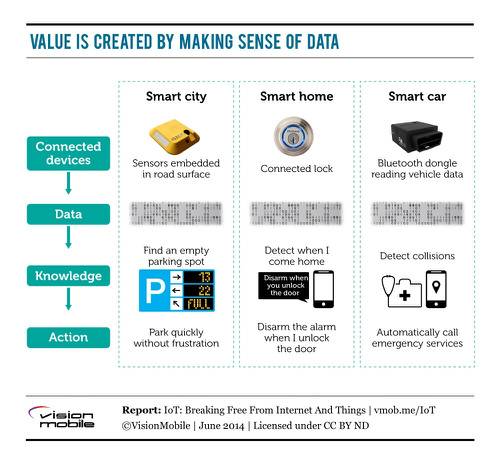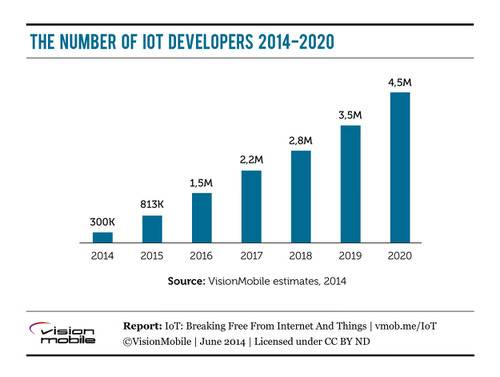It’s standard to size a market by the number of widgets sold, but in the Internet of Things, which numbers sensors and devices in the billions, widget counts don’t really matter. In part this is because the real money in IoT is not in the “things,” but rather in the Internet-enabled services that stitch them together.
See also: The Internet Of Things: The Real Money Is In The Internet, Not The Things
More to the point, it’s because the size of the IoT market fundamentally depends on the number of developers creating value in it. While today there are just 300,000 developers contributing to the IoT, a new report from VisionMobile projects a whopping 4.5 million developers by 2020, reflecting a 57% compound annual growth rate and a massive market opportunity.
Start Making Sense
In the last 30 years we’ve created a fair amount of data, but it pales compared to what we’ve generated just in the last two years. Ninety percent of the world’s data was generated in the last two years alone, much of it by machines. Such machine-produced data dwarfs human-generated data.
In such an IoT world, devices are not the problem. According to Gartner, we’ll have 26 billion of them by 2020. Connecting them isn’t, either. As VisionMobile’s report makes clear, however, “making sense of data” is the real challenge.
It’s also the big opportunity:

Just honing in on the middle column, Google acquired Nest for $3.2 billion, and just six days ago Google’s Nest acquired Dropcam for $555 million. Dropcam’s cameras upload more data every day than users put up on YouTube. That’s a lot of data, and a lot of money.
It all comes down to developers, because it’s developers and the companies they work for that are pulling intelligence from the data.
More Data Requires More Developers
Fortunately, we’re about to get a huge crowd of developers actively contributing to IoT applications—4.5 million of them by 2020, according to VisionMobile.

As VisionMobile suggests, “the only way to make a profit in the Internet of Things is to build a network of entrepreneurs who create unique value on top of commodity hardware, connectivity and cloud services.” Here’s a more detailed explanation:
The key to being successful with developer-centric business models is to find a way to bundle your core product with the new demand generated by developers. Much like Apple bundles its devices with million apps in the App Store, Google bundles its online services with Android devices. Through these services, Google collects user intelligence and creates opportunities to expand its ad inventory. Amazon as well bundles its e-commerce services with subsidized Kindle tablets (and soon smartphones) to drive user traffic to its virtual store shelves.
In other words, developers aren’t the buying audience: they create the ecosystem that makes other buyers interested in buying hardware, cloud services or some other value.
What Will They Build?
As much as we may want to fantasize about refrigerators talking to coffee machines, the reality is that we have no clue what meaningful applications will emerge from the IoT opportunity. As the report authors state, “Demand for IoT technology will not come from a single killer app, but from thousands of unexpected new use cases.”
No single company will win in the IoT, nor will any one app. Such developer-driven demand “will create new Internet of Things markets that are several times bigger than the ones we could ever predict with a spreadsheet that extrapolates today’s market.” The only thing we know for sure is that developers are fundamental to making IoT a big, profitable market, even if they don’t pay a single dime for a single sensor in that market.
Lead image by Flickr contributor Official GDC, CC 2.0

















